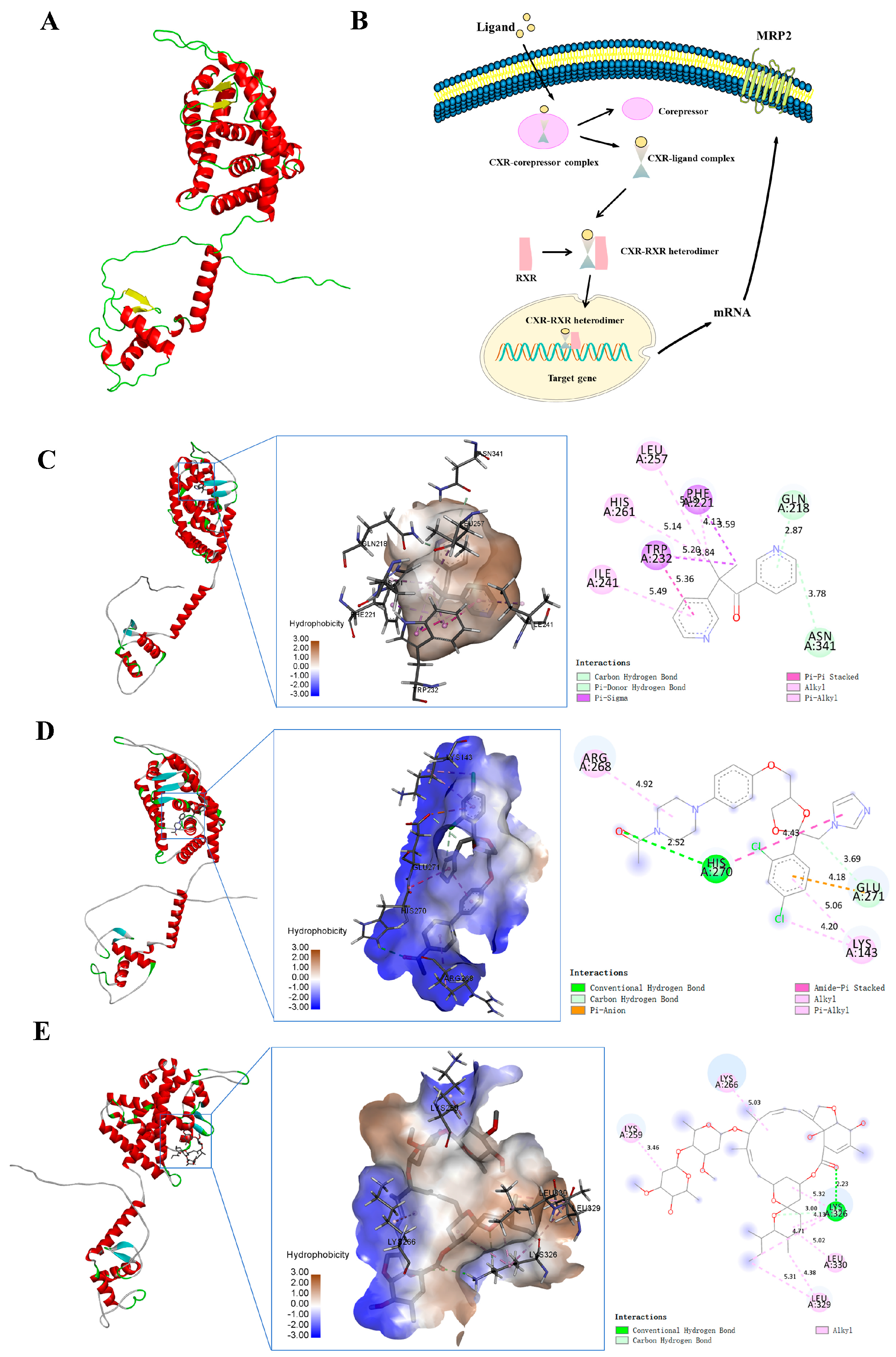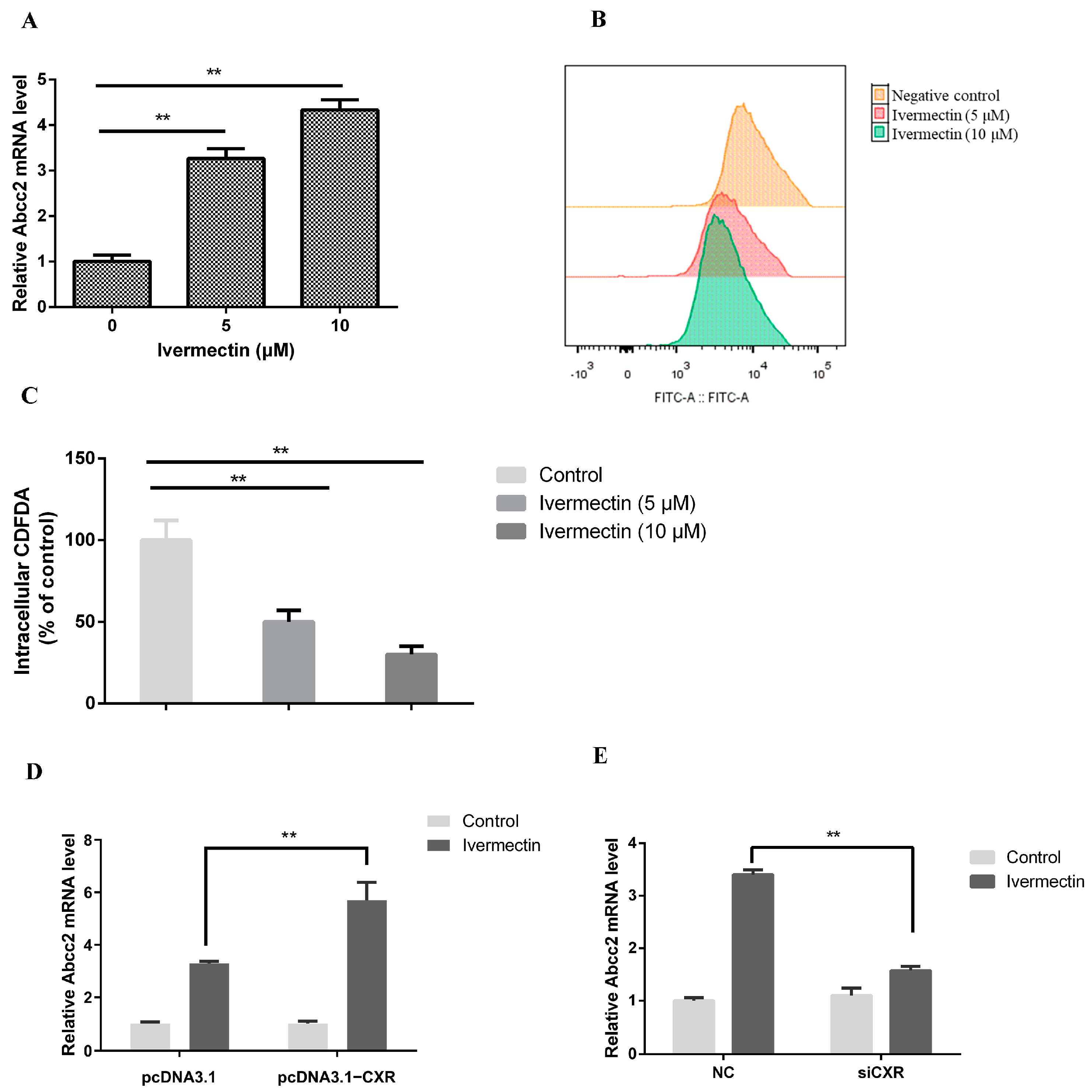Gene Expression of Abcc2 and Its Regulation by Chicken Xenobiotic Receptor
Abstract
1. Introduction
2. Materials and Methods
2.1. Materials and Cell Culture
2.2. Bioinformatics Analysis and Protein Structural Models of Chicken MRP2
2.3. Molecular Modeling
2.4. Animals and Tissue Sample Collection
2.5. RNA Isolation, RT-PCR, and PCR Analysis
2.6. Flow Cytometry Analysis
2.7. SiRNA and Overexpression of CXR
2.8. Statistical Analysis
3. Results
3.1. Sequence Analysis of Chicken MRP2
3.2. Abcc2 mRNA Expression in Chicken Tissues
3.3. Docking of CXR with Small Molecules
3.4. CXR Dependence of Abcc2 Induction
3.5. Ivermectin-Activated CXR Induces Abcc2 Expression and Function
3.6. CXR-Mediated Induction of Abcc2 in Chicken
4. Discussion
5. Conclusions
Supplementary Materials
Author Contributions
Funding
Institutional Review Board Statement
Informed Consent Statement
Data Availability Statement
Conflicts of Interest
References
- Chen, Z.; Shi, T.; Zhang, L.; Zhu, P.; Deng, M.; Huang, C.; Hu, T.; Jiang, L.; Li, J. Mammalian drug efflux transporters of the ATP binding cassette (ABC) family in multidrug resistance: A review of the past decade. Cancer Lett. 2016, 370, 153–164. [Google Scholar] [CrossRef] [PubMed]
- Nguyen, T.D.; Markova, S.; Liu, W.; Gow, J.M.; Baldwin, R.M.; Habashian, M.; Relling, M.V.; Ratain, M.J.; Kroetz, D.L. Functional characterization of ABCC2 promoter polymorphisms and allele-specific expression. Pharmacogenom. J. 2013, 13, 396–402. [Google Scholar] [CrossRef]
- Nies, A.T.; Keppler, D. The apical conjugate efflux pump ABCC2 (MRP2). Pflug. Arch. Eur. J. Physiol. 2007, 453, 643–659. [Google Scholar] [CrossRef] [PubMed]
- Bruhn, O.; Cascorbi, I. Polymorphisms of the drug transporters ABCB1, ABCG2, ABCC2 and ABCC3 and their impact on drug bioavailability and clinical relevance. Expert Opin. Drug Metab. Toxicol. 2014, 10, 1337–1354. [Google Scholar] [CrossRef]
- Baiceanu, E.; Crisan, G.; Loghin, F.; Falson, P. Modulators of the human ABCC2: Hope from natural sources? Future Med. Chem. 2015, 7, 2041–2063. [Google Scholar] [CrossRef] [PubMed]
- Thomas, C.; Tampé, R. Multifaceted structures and mechanisms of ABC transport systems in health and disease. Curr. Opin. Struct. Biol. 2018, 51, 116–128. [Google Scholar] [CrossRef]
- Gupta, S.K.; Singh, P.; Ali, V.; Verma, M. Role of membrane-embedded drug efflux ABC transporters in the cancer chemotherapy. Oncol. Rev. 2020, 14, 448. [Google Scholar] [CrossRef] [PubMed]
- Mohammad, I.S.; He, W.; Yin, L. Understanding of human ATP binding cassette superfamily and novel multidrug resistance modulators to overcome MDR. Biomed. Pharmacother. 2018, 100, 335–348. [Google Scholar] [CrossRef]
- Järvinen, E.; Kidron, H.; Finel, M. Human efflux transport of testosterone, epitestosterone and other androgen glucuronides. J. Steroid Biochem. Mol. Biol. 2020, 197, 105518. [Google Scholar] [CrossRef]
- Järvinen, E.; Deng, F.; Kidron, H.; Finel, M. Efflux transport of estrogen glucuronides by human MRP2, MRP3, MRP4 and BCRP. J. Steroid Biochem. Mol. Biol. 2018, 178, 99–107. [Google Scholar] [CrossRef]
- Pan, Q.; Zhang, X.; Zhang, L.; Cheng, Y.; Zhao, N.; Li, F.; Zhou, X.; Chen, S.; Li, J.; Xu, S.; et al. Solute Carrier Organic Anion Transporter Family Member 3A1 Is a Bile Acid Efflux Transporter in Cholestasis. Gastroenterology 2018, 155, 1578–1592.e1516. [Google Scholar] [CrossRef] [PubMed]
- Csandl, M.; Conseil, G.; Cole, S. Effect of Leukotriene Modifiers on Transport Activity of Multidrug Resistance Proteins (MRPs). FASEB J. 2015, 29, 939.4. [Google Scholar] [CrossRef]
- Saib, S.; Delavenne, X. Inflammation Induces Changes in the Functional Expression of P-gp, BCRP, and MRP2: An Overview of Different Models and Consequences for Drug Disposition. Pharmaceutics 2021, 13, 1544. [Google Scholar] [CrossRef] [PubMed]
- Li, C.Y.; Basit, A.; Gupta, A.; Gáborik, Z.; Kis, E.; Prasad, B. Major glucuronide metabolites of testosterone are primarily transported by MRP2 and MRP3 in human liver, intestine and kidney. J. Steroid Biochem. Mol. Biol. 2019, 191, 105350. [Google Scholar] [CrossRef]
- Arana, M.R.; Tocchetti, G.N.; Rigalli, J.P.; Mottino, A.D.; Villanueva, S.S. Physiological and pathophysiological factors affecting the expression and activity of the drug transporter MRP2 in intestine. Impact on its function as membrane barrier. Pharmacol. Res. 2016, 109, 32–44. [Google Scholar] [CrossRef]
- Zhou, Y.; Zhang, G.Q.; Wei, Y.H.; Zhang, J.P.; Zhang, G.R.; Ren, J.X.; Duan, H.G.; Rao, Z.; Wu, X.A. The impact of drug transporters on adverse drug reaction. Eur. J. Drug Metab. Pharmacokinet. 2013, 38, 77–85. [Google Scholar] [CrossRef] [PubMed]
- Kobayashi, T.; Takeba, Y.; Ohta, Y.; Ootaki, M.; Kida, K.; Watanabe, M.; Iiri, T.; Matsumoto, N. Prenatal glucocorticoid administration enhances bilirubin metabolic capacity and increases Ugt1a and Abcc2 gene expression via glucocorticoid receptor and PXR in rat fetal liver. J. Obstet. Gynaecol. Res. 2022, 48, 1591–1606. [Google Scholar] [CrossRef] [PubMed]
- Lemmen, J.; Tozakidis, I.E.; Galla, H.J. Pregnane X receptor upregulates ABC-transporter Abcg2 and Abcb1 at the blood-brain barrier. Brain Res. 2013, 1491, 1–13. [Google Scholar] [CrossRef]
- Jedlitschky, G.; Hoffmann, U.; Kroemer, H.K. Structure and function of the MRP2 (ABCC2) protein and its role in drug disposition. Expert Opin. Drug Metab. Toxicol. 2006, 2, 351–366. [Google Scholar] [CrossRef]
- di Masi, A.; De Marinis, E.; Ascenzi, P.; Marino, M. Nuclear receptors CAR and PXR: Molecular, functional, and biomedical aspects. Mol. Asp. Med. 2009, 30, 297–343. [Google Scholar] [CrossRef]
- Burk, O.; Koch, I.; Raucy, J.; Hustert, E.; Eichelbaum, M.; Brockmöller, J.; Zanger, U.M.; Wojnowski, L. The induction of cytochrome P450 3A5 (CYP3A5) in the human liver and intestine is mediated by the xenobiotic sensors pregnane X receptor (PXR) and constitutively activated receptor (CAR). J. Biol. Chem. 2004, 279, 38379–38385. [Google Scholar] [CrossRef]
- Banerjee, M.; Robbins, D.; Chen, T. Targeting xenobiotic receptors PXR and CAR in human diseases. Drug Discov. Today 2015, 20, 618–628. [Google Scholar] [CrossRef] [PubMed]
- Karpale, M.; Hukkanen, J.; Hakkola, J. Nuclear Receptor PXR in Drug-Induced Hypercholesterolemia. Cells 2022, 11, 313. [Google Scholar] [CrossRef] [PubMed]
- Teng, S.; Piquette-Miller, M. Hepatoprotective role of PXR activation and MRP3 in cholic acid-induced cholestasis. Br. J. Pharmacol. 2007, 151, 367–376. [Google Scholar] [CrossRef] [PubMed]
- He, J.; Nishida, S.; Xu, M.; Makishima, M.; Xie, W. PXR prevents cholesterol gallstone disease by regulating biosynthesis and transport of bile salts. Gastroenterology 2011, 140, 2095–2106. [Google Scholar] [CrossRef]
- Mani, S.; Dou, W.; Redinbo, M.R. PXR antagonists and implication in drug metabolism. Drug Metab. Rev. 2013, 45, 60–72. [Google Scholar] [CrossRef] [PubMed]
- Handschin, C.; Podvinec, M.; Meyer, U.A. CXR, a chicken xenobiotic-sensing orphan nuclear receptor, is related to both mammalian pregnane X receptor (PXR) and constitutive androstane receptor (CAR). Proc. Natl. Acad. Sci. USA 2000, 97, 10769–10774. [Google Scholar] [CrossRef]
- Zhang, Y.; Huang, J.; Li, X.; Fang, C.; Wang, L. Identification of Functional Transcriptional Binding Sites within Chicken Abcg2 Gene Promoter and Screening Its Regulators. Genes 2020, 11, 186. [Google Scholar] [CrossRef]
- Shepherd, M. The CydDC ABC transporter of Escherichia coli: New roles for a reductant efflux pump. Biochem. Soc. Trans. 2015, 43, 908–912. [Google Scholar] [CrossRef][Green Version]
- Haritova, A.M.; Rusenova, N.V.; Rusenov, A.G.; Schrickx, J.; Lashev, L.D.; Fink-Gremmels, J. Effects of fluoroquinolone treatment on MDR1 and MRP2 mRNA expression in Escherichia coli-infected chickens. Avian Pathol. 2008, 37, 465–470. [Google Scholar] [CrossRef][Green Version]
- Fei, Z.; Hu, M.; Baum, L.; Kwan, P.; Hong, T.; Zhang, C. The potential role of human multidrug resistance protein 1 (MDR1) and multidrug resistance-associated protein 2 (MRP2) in the transport of Huperzine A in vitro. Xenobiotica/Fate Foreign Compd. Biol. Syst. 2020, 50, 354–362. [Google Scholar] [CrossRef]
- Xu, Z.; Li, M.; Lu, W.; Wang, L.; Zhang, Y. Chicken xenobiotic receptor upregulates the BCRP/ABCG2 transporter. Poult. Sci. 2023, 102, 102278. [Google Scholar] [CrossRef]
- Borst, P.; Zelcer, N.; van de Wetering, K. MRP2 and 3 in health and disease. Cancer Lett. 2006, 234, 51–61. [Google Scholar] [CrossRef] [PubMed]
- Lee, J.H.; Chen, H.L.; Chen, H.L.; Ni, Y.H.; Hsu, H.Y.; Chang, M.H. Neonatal Dubin-Johnson syndrome: Long-term follow-up and MRP2 mutations study. Pediatr. Res. 2006, 59, 584–589. [Google Scholar] [CrossRef]
- Chu, X.Y.; Strauss, J.R.; Mariano, M.A.; Li, J.; Newton, D.J.; Cai, X.; Wang, R.W.; Yabut, J.; Hartley, D.P.; Evans, D.C.; et al. Characterization of mice lacking the multidrug resistance protein MRP2 (ABCC2). J. Pharmacol. Exp. Ther. 2006, 317, 579–589. [Google Scholar] [CrossRef] [PubMed]
- Ah, Y.M.; Kim, Y.M.; Kim, M.J.; Choi, Y.H.; Park, K.H.; Son, I.J.; Kim, S.G. Drug-induced hyperbilirubinemia and the clinical influencing factors. Drug Metab. Rev. 2008, 40, 511–537. [Google Scholar] [CrossRef] [PubMed]
- Kroll, T.; Prescher, M.; Smits, S.H.J.; Schmitt, L. Structure and Function of Hepatobiliary ATP Binding Cassette Transporters. Chem. Rev. 2021, 121, 5240–5288. [Google Scholar] [CrossRef]
- Wen, X.; Joy, M.S.; Aleksunes, L.M. In Vitro Transport Activity and Trafficking of MRP2/ABCC2 Polymorphic Variants. Pharm. Res. 2017, 34, 1637–1647. [Google Scholar] [CrossRef]
- Sequence and comparative analysis of the chicken genome provide unique perspectives on vertebrate evolution. Nature 2004, 432, 695–716. [CrossRef]
- Thomas, C.; Tampé, R. Structural and Mechanistic Principles of ABC Transporters. Annu. Rev. Biochem. 2020, 89, 605–636. [Google Scholar] [CrossRef]
- Holland, I.B.; Blight, M.A. ABC-ATPases, adaptable energy generators fuelling transmembrane movement of a variety of molecules in organisms from bacteria to humans. J. Mol. Biol. 1999, 293, 381–399. [Google Scholar] [CrossRef] [PubMed]
- Pérez-Tomás, R. Multidrug resistance: Retrospect and prospects in anti-cancer drug treatment. Curr. Med. Chem. 2006, 13, 1859–1876. [Google Scholar] [CrossRef] [PubMed]
- Zhang, Y.; Yang, S.H.; Guo, X.L. New insights into Vinca alkaloids resistance mechanism and circumvention in lung cancer. Biomed. Pharmacother. 2017, 96, 659–666. [Google Scholar] [CrossRef] [PubMed]
- Brueck, S.; Bruckmueller, H.; Wegner, D.; Busch, D.; Martin, P.; Oswald, S.; Cascorbi, I.; Siegmund, W. Transcriptional and Post-Transcriptional Regulation of Duodenal P-Glycoprotein and MRP2 in Healthy Human Subjects after Chronic Treatment with Rifampin and Carbamazepine. Mol. Pharm. 2019, 16, 3823–3830. [Google Scholar] [CrossRef]
- König, J.; Müller, F.; Fromm, M.F. Transporters and drug-drug interactions: Important determinants of drug disposition and effects. Pharmacol. Rev. 2013, 65, 944–966. [Google Scholar] [CrossRef]
- Liu, X. Transporter-Mediated Drug-Drug Interactions and Their Significance. Adv. Exp. Med. Biol. 2019, 1141, 241–291. [Google Scholar] [CrossRef]








| Name | Primer Sequence (5′–3′) |
|---|---|
| Abcc2 (MRP2)-F | CTGCAGCAAAATGAGAGGACAATG |
| Abcc2 (MRP2)-R | CAGAAGCGCAGAGAAGAAGACCAC |
| β-actin-F | TGCGTGACATCAAGGAGAAG |
| β-actin-R | TGCCAGGGTACATTGTGGTA |
Disclaimer/Publisher’s Note: The statements, opinions and data contained in all publications are solely those of the individual author(s) and contributor(s) and not of MDPI and/or the editor(s). MDPI and/or the editor(s) disclaim responsibility for any injury to people or property resulting from any ideas, methods, instructions or products referred to in the content. |
© 2024 by the authors. Licensee MDPI, Basel, Switzerland. This article is an open access article distributed under the terms and conditions of the Creative Commons Attribution (CC BY) license (https://creativecommons.org/licenses/by/4.0/).
Share and Cite
Gao, Y.; Deng, H.; Zhao, Y.; Li, M.; Wang, L.; Zhang, Y. Gene Expression of Abcc2 and Its Regulation by Chicken Xenobiotic Receptor. Toxics 2024, 12, 55. https://doi.org/10.3390/toxics12010055
Gao Y, Deng H, Zhao Y, Li M, Wang L, Zhang Y. Gene Expression of Abcc2 and Its Regulation by Chicken Xenobiotic Receptor. Toxics. 2024; 12(1):55. https://doi.org/10.3390/toxics12010055
Chicago/Turabian StyleGao, Yanhong, Huacheng Deng, Yuying Zhao, Mei Li, Liping Wang, and Yujuan Zhang. 2024. "Gene Expression of Abcc2 and Its Regulation by Chicken Xenobiotic Receptor" Toxics 12, no. 1: 55. https://doi.org/10.3390/toxics12010055
APA StyleGao, Y., Deng, H., Zhao, Y., Li, M., Wang, L., & Zhang, Y. (2024). Gene Expression of Abcc2 and Its Regulation by Chicken Xenobiotic Receptor. Toxics, 12(1), 55. https://doi.org/10.3390/toxics12010055






